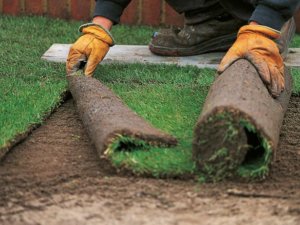 TURF INSTALLATION
TURF INSTALLATION
Only on very hot days, water prepared area lightly, enough to take the heat out of the soil to prevent scorching the sod roots.
Install your lawn immediately. Begin installing along the longest straight line, such as a driveway or sidewalk. Butt and push edges and ends against each other tightly, without stretching. Avoid gaps and overlaps. Stagger the joints in each row in a brick-like fashion, using a large sharp knife, hatchet or spade, to trim corners, etc. Avoid leaving small strips at outer edges as they will not retain moisture. On slopes place sod across the slope.
Once you get an area big enough to water, roll sod to improve soil contact and remove air pockets (roots dry out fast with no soil contact). Remember, sod requires ground contact and moisture to survive.
To avoid causing indentations or air pockets avoid repeating walking or kneeling on sod while being installed or just after watering.
In hot weather, protect unlaid sod by sprinkling with water on outside edges.
SOIL PREPARATION
Weedy perennial grasses should be killed before an area is sodded. Use a suitable herbicide to eradicate these weedy grasses. If you are using Round-up, apply 2 weeks before soil preparation (read instructions on packaging).
For best results, rototill area to a depth of at least 2-3 inches. For new home construction bring 1 ½ to 2 inches of top spoil and rototill area mixing the top soil with existing soil. Eliminate drainage problems by having soil slope away foundations, etc. Keep the grade ¾ – 1 inch below sidewalk and driveway. Roll area lightly with a lawn roller 1/3 full of
water or water thoroughly and allow time settling. This will firm the soil and reveal low areas that need more soil.
Then rake in fertilizer low in nitrogen and high in phosphorous and potassium (such as 5-20-20 or 6-24-24) at 10-15 lbs. per 1,000 sq. ft., before the sod arrives on site.
